
Top 5 Sikh Successes of 2007
Although this blog is new, I couldn’t resist getting the in the ‘countdown’ spirit with another useless list. Oh well, the end of the calendar year (although not the Nanakshahi Sikh calendar) gives us some time for thoughts and reflections. Here is my list of this year’s top 5 events that will influence 2008 and beyond.
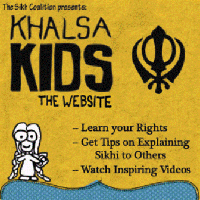 5. Khalsa Kids – The Sikh diaspora is coming of age and creating new tools for the community. It has been over ten years since the suicide of 13 year old Vijay Singh in the UK after being repeatedly bullied in school. Unfortunately the bullying of young Sikh boys tends to be the rule and not the exception. The Sikh Coalition released a harrowing report that showed 77.5% of Sikh boys surveyed in Queens reported being teased or harassed on account of their Sikh identity. However, the community is beginning to respond and it reveals a coming of age here in the US Sikh population.
5. Khalsa Kids – The Sikh diaspora is coming of age and creating new tools for the community. It has been over ten years since the suicide of 13 year old Vijay Singh in the UK after being repeatedly bullied in school. Unfortunately the bullying of young Sikh boys tends to be the rule and not the exception. The Sikh Coalition released a harrowing report that showed 77.5% of Sikh boys surveyed in Queens reported being teased or harassed on account of their Sikh identity. However, the community is beginning to respond and it reveals a coming of age here in the US Sikh population.
A Sikh teacher, SriNam Singh Khalsa, recently published Break the Bully Cycle: Intervention Techniques and Activities to Create a Respectful School Community. This book provides strategies to enable school teachers and administrators in helping not only the victims of bullies, but also the bullies themselves. Another book, written by a Sikh high school student, Harkirat Singh Hansra, helps to give non-Sikhs, especially students, a basic understanding on Sikhi. Titled Liberty at Stake – Sikhs: The Most Visible Yet Understood Minority in America provides a Sikh teenager’s perspective of the world around him. Finally, perhaps the most innovative project was the Sikh Coalition’s launch of its Khalsa Kids website. Fun, interactive, and professional the Sikh Coalition must be commended for creating a real tool that will serve Sikh communities throughout the world. That the Sikh community has a multi-faceted approach and is using its resources is a great success of 2007 that will set the bar for 2008 and beyond.
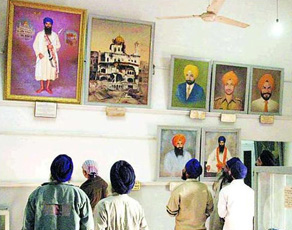 4. Bhindranwale’s picture in the Sikh Museum – Although this controversy broke out during the last month of the year, its notability makes it worthy of inclusion. Demands for the installation of Sant Jarnail Singh Bhindranwale’s picture in the Sikh Museum at Darbar Sahib had been raised for some time. Finally the SGPC acquiesced to the views of the Sikh community. No sooner was the portrait installed than the Sangh Parivar and its allies were threatening action. The Shiv Sena even offered a reward of for anyone that would tear down the portrait. Many Sikhs were puzzled as the portraits of other Shaheeds of 1984 had been in the Sikh Museum for decades. Bhindranwale’s posters and cassettes have been widely available and distributed for years. Bhindranwale merchandise is a top-seller throughout Punjab and is extremely popular at rural melas and events. The Immortal Shaheedi albums and songs by Tigerstyle are only now beginning to reach the Punjab countryside and are popular amongst the youth. Although seemingly completely senile, there may be truth to Khushwant Singh’s comment that the
4. Bhindranwale’s picture in the Sikh Museum – Although this controversy broke out during the last month of the year, its notability makes it worthy of inclusion. Demands for the installation of Sant Jarnail Singh Bhindranwale’s picture in the Sikh Museum at Darbar Sahib had been raised for some time. Finally the SGPC acquiesced to the views of the Sikh community. No sooner was the portrait installed than the Sangh Parivar and its allies were threatening action. The Shiv Sena even offered a reward of for anyone that would tear down the portrait. Many Sikhs were puzzled as the portraits of other Shaheeds of 1984 had been in the Sikh Museum for decades. Bhindranwale’s posters and cassettes have been widely available and distributed for years. Bhindranwale merchandise is a top-seller throughout Punjab and is extremely popular at rural melas and events. The Immortal Shaheedi albums and songs by Tigerstyle are only now beginning to reach the Punjab countryside and are popular amongst the youth. Although seemingly completely senile, there may be truth to Khushwant Singh’s comment that the
Bhindranwale’s ghost still stalks the Punjab countryside disturbing the sleep of the Punjabi Hindu and the conscience of the Punjabi Sikh.
Despite the empty threats of the Sangh Parivar, the SGPC has stood firm with the Sikh community. The most critical point is that a community decides its own heroes and that no other community should be able to interfere with its decision. Whether one agrees or disagrees with the views and deeds of Sant Jarnail Singh Bhindranwale, it is undoubted that he was one of the most influential Sikhs of the 20th century and continues to be in the 21st. He deserves a place in the Sikh Museum now and forever.
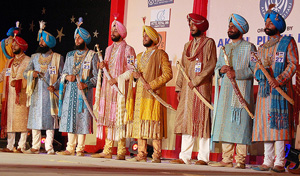 3. Ishmeet and the ‘Sikh Turn’ – It may seem odd that we would include the winner of an Indian talent show in our top 3, but the issue is far bigger than Ishmeet. The pagri is the flag of the Punjabi Sikhs. Although many worry that it is disappearing in Punjab, its place in the psyche of Punjabi Sikh remains strong. Whether in the movie Dil Apna Punjabi, Ravinder Grewal’s Pagh or Pammi Bai’s Pagg many Sikhs are rallying behind the importance of the turban. Recent songs by Inderjit Nikku, Deepak Dhillon, Hardev Mahinangal (the list is long) also all revolve around the turban. The Amritsar-based Akal Purakh Ki Fauj, the vanguard organization in taking on this issue, has successfully organized a Mr. Singh International Beauty competition, created turban tying videos, and even ‘smart turban’ software. Although many Sikh youths have for the time being removed their turbans, their sense of a religio-ethnic identity still remains strong. Maybe the temptations of modernity and especially the desires of the opposite sex are strong and many feel that at this point in their life they would rather pursue women and cannot live up to the great ideals of their Gurus. This should not be read as a rejection of those ideals but a realization of where they are and their priorities at this time. (Though this may be the case of those that remove their pagri on their own account and not in those families and children where they never had it as many in the diaspora) The way the Punjabi Sikh youth rallied behind Ishmeet Singh’s turban to win him the title of ‘Star Voice of India’ shows, however, that the pagri flag does create unifying marker. The success of Rohanpreet Singh of Patiala in the Sa Re Ga Ma Pa Lil Champs 2007 competition may mobilize the same Sikh support throughout Punjab and the world.
3. Ishmeet and the ‘Sikh Turn’ – It may seem odd that we would include the winner of an Indian talent show in our top 3, but the issue is far bigger than Ishmeet. The pagri is the flag of the Punjabi Sikhs. Although many worry that it is disappearing in Punjab, its place in the psyche of Punjabi Sikh remains strong. Whether in the movie Dil Apna Punjabi, Ravinder Grewal’s Pagh or Pammi Bai’s Pagg many Sikhs are rallying behind the importance of the turban. Recent songs by Inderjit Nikku, Deepak Dhillon, Hardev Mahinangal (the list is long) also all revolve around the turban. The Amritsar-based Akal Purakh Ki Fauj, the vanguard organization in taking on this issue, has successfully organized a Mr. Singh International Beauty competition, created turban tying videos, and even ‘smart turban’ software. Although many Sikh youths have for the time being removed their turbans, their sense of a religio-ethnic identity still remains strong. Maybe the temptations of modernity and especially the desires of the opposite sex are strong and many feel that at this point in their life they would rather pursue women and cannot live up to the great ideals of their Gurus. This should not be read as a rejection of those ideals but a realization of where they are and their priorities at this time. (Though this may be the case of those that remove their pagri on their own account and not in those families and children where they never had it as many in the diaspora) The way the Punjabi Sikh youth rallied behind Ishmeet Singh’s turban to win him the title of ‘Star Voice of India’ shows, however, that the pagri flag does create unifying marker. The success of Rohanpreet Singh of Patiala in the Sa Re Ga Ma Pa Lil Champs 2007 competition may mobilize the same Sikh support throughout Punjab and the world.
As discussed previously, the ‘Sikh turn’ is occurring. The psychological tragedy of the post-1993 Sikh community is beginning to wane and we may be witnessing the dawn of a new era. It may not be in the Khalsa symbolic form that many hope, but a religio-ethnic movement is occurring. The youth are not disinterested and disconnected; they are engaged and can be mobilized. The pull of the pagri is not dead in Punjab either as we see many Bihari migrants joining the Qaum’s ranks. This is a good sign. A new generation will soon have its own version of ‘pagri sambhal jatta.’
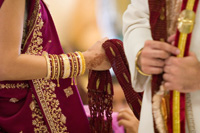 2. Pakistani Sikh Anand Marriage Act – That many Sikh organizations clamoring to take credit for this legislation shows that there is an understanding of its success and implications. The passage of the original Anand Marriage Act in 1909 was seen as a success of the Singh Sabha Movement and its relationship with the British Raj. The Act was seen as recognition of the Sikh community’s long-standing independent status. Now in legislative and judiciary workings they would be on the same footing as that of Muslims and Hindus. It was with the transfer of power and creation of India and Pakistan that this Act was said to fall within the Hindu Marriage Act of 1955. As the Sikh constitutional representatives saw that the progress of recognition was being rolled back, they refused to sign the Indian constitution. Members from time to time remind the community that no Sikh has ever signed the Indian constitution as within it, Sikhs, Jains and Buddhists lost their legislative independent status and fall within the lumped category of ‘Hindus.’ Sant Jarnail Singh Bhindranwale often reminded Sikhs that if they believe they have an independent status within the Indian state, look no further than their marriage certificate that is signed under the ‘Hindu Marriage Act’ and compare that to the separate status of the Muslim and Christian communities. The recent efforts of the Pakistan Sikh Gurdwara Prabandhak Committee and American Gurdwara Parbhandak Committee bore fruition this November during the 539th birth anniversary of Sikh founder – Guru Nanak, when Pakistan’s Federal Law Minister, Sayed Afzel, announced at Nankana Sahib that Pakistan will recognize and enact legislation recognizing the Anand Marriage Act. For the globalized Sikh communities this success will spark increased debate in India and beyond. Despite the continuing disappointment of the Sikh communities’ position in France, success in this matter in Pakistan gives new hope and new legislative impetus for the Sikh community in 2008 and beyond.
2. Pakistani Sikh Anand Marriage Act – That many Sikh organizations clamoring to take credit for this legislation shows that there is an understanding of its success and implications. The passage of the original Anand Marriage Act in 1909 was seen as a success of the Singh Sabha Movement and its relationship with the British Raj. The Act was seen as recognition of the Sikh community’s long-standing independent status. Now in legislative and judiciary workings they would be on the same footing as that of Muslims and Hindus. It was with the transfer of power and creation of India and Pakistan that this Act was said to fall within the Hindu Marriage Act of 1955. As the Sikh constitutional representatives saw that the progress of recognition was being rolled back, they refused to sign the Indian constitution. Members from time to time remind the community that no Sikh has ever signed the Indian constitution as within it, Sikhs, Jains and Buddhists lost their legislative independent status and fall within the lumped category of ‘Hindus.’ Sant Jarnail Singh Bhindranwale often reminded Sikhs that if they believe they have an independent status within the Indian state, look no further than their marriage certificate that is signed under the ‘Hindu Marriage Act’ and compare that to the separate status of the Muslim and Christian communities. The recent efforts of the Pakistan Sikh Gurdwara Prabandhak Committee and American Gurdwara Parbhandak Committee bore fruition this November during the 539th birth anniversary of Sikh founder – Guru Nanak, when Pakistan’s Federal Law Minister, Sayed Afzel, announced at Nankana Sahib that Pakistan will recognize and enact legislation recognizing the Anand Marriage Act. For the globalized Sikh communities this success will spark increased debate in India and beyond. Despite the continuing disappointment of the Sikh communities’ position in France, success in this matter in Pakistan gives new hope and new legislative impetus for the Sikh community in 2008 and beyond.
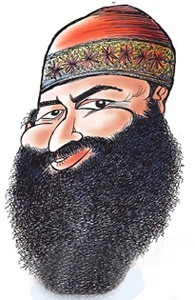 1. Dera Sacha Sauda Incident – No other issue galvanized the Sikh community this year than the Dera Sacha Sauda incident. The Indian press and those with little understanding of the community falsely labeled this as some sort of form of ‘fundamentalism’ at issue. Such a misreading displays little understanding of the dynamics of the Sikh community. The issue had long been simmering with a number of different Dera Babas and their proliferation throughout the state. Previous confrontations with Bhaniarawala, Ashutosh, and the Nirankaris have created a long continuous history of such confrontations. Conflicts arise and become violent only with those deras that try to appropriate the symbolism and heritage of the distinct Sikh Qaum as their own. The chief of Bhaniarawala not only sponsored a book that he wished to call a ‘granth,’ at events he purposely placed it higher than the Sikhs’ revered Guru Granth Sahib and still later had birs of the Guru Granth Sahib burned. Ashutosh began claiming himself as the living embodiment of the Guru Granth Sahib and thus the Khalsa Panth and Guru Granth are no longer needed. Dera Sacha Sauda’s chief not only attempted to make himself equal by donning the iconography of Guru Gobind Singh, but attempted to imitate one of the most critical events – the founding of the Khalsa – as his own. Although one hopes that such ridiculous attempts would not be made by these cheats and violence would not be employed as countermeasures, the community will stand up for its honor against invasions and disrespect by others that try to appropriate its lineage, history, and symbolic icons.
1. Dera Sacha Sauda Incident – No other issue galvanized the Sikh community this year than the Dera Sacha Sauda incident. The Indian press and those with little understanding of the community falsely labeled this as some sort of form of ‘fundamentalism’ at issue. Such a misreading displays little understanding of the dynamics of the Sikh community. The issue had long been simmering with a number of different Dera Babas and their proliferation throughout the state. Previous confrontations with Bhaniarawala, Ashutosh, and the Nirankaris have created a long continuous history of such confrontations. Conflicts arise and become violent only with those deras that try to appropriate the symbolism and heritage of the distinct Sikh Qaum as their own. The chief of Bhaniarawala not only sponsored a book that he wished to call a ‘granth,’ at events he purposely placed it higher than the Sikhs’ revered Guru Granth Sahib and still later had birs of the Guru Granth Sahib burned. Ashutosh began claiming himself as the living embodiment of the Guru Granth Sahib and thus the Khalsa Panth and Guru Granth are no longer needed. Dera Sacha Sauda’s chief not only attempted to make himself equal by donning the iconography of Guru Gobind Singh, but attempted to imitate one of the most critical events – the founding of the Khalsa – as his own. Although one hopes that such ridiculous attempts would not be made by these cheats and violence would not be employed as countermeasures, the community will stand up for its honor against invasions and disrespect by others that try to appropriate its lineage, history, and symbolic icons.
The Dera Sacha Sauda incident saw waves of Sikh youth rallying behind the cause. Motorcycle morchas (processions) were seen throughout the state. These groups were not only Amritdhari or Keshadhari Sikhs, but involved many others that have a connection to their Guru. It was due to the youth pressure that the Sikh clergy had to take positions that it did not want to take. Sikhs should not look towards the old establishment (Akali Dal, SGPC, Jathedars, etc) for leadership, but the Sikh youth must itself be ready to lead. The mobilization of Sikh masses in defense of the Sikh religion shows that the spirit of the community is alive and engaged. This is an example of the ‘Sikh turn’ mentioned earlier.
With the rise of the Dera Sacha Sauda incident to prominence, much ink has been spilled in trying to understand the phenomenon. We hope that members of the Sikh community recommit themselves to fighting casteism and other hierarchies that have led members of our community to find refuge in the lairs of liars. Understanding the phenomenon and making changes in one’s own life is the key to our salvation as a community.
While I wish I could include more social issues, such as sex-selective abortion, the rise of drug abuse, violence against women, casteism, these are systemic problems where progress usually is not made in data points on a ‘top 5’ list. However, these systemic issues are some of the key issues that I hope the Sikh community resolves to combat and recommit to alleviate by following the examples of our beloved Gurus.
So these are my top 5 takes….agree/disagree? What are yours?














[…] Sikh Coalition has a wonderful internet tool, which was previously discussed on this blog, called Khalsa Kids that seeks to address the problem of bullying against Sikhs in […]
[…] in one of Jodha’s first posts recalling the “Top 5 Sikh Successes of 2007,” he wrote: As discussed previously, the ‘Sikh turn’ is occurring. The psychological […]
[…] Top 5 Sikh Successes of 2007 […]
[…] in an earlier discussion I talked about the importance of the KhalsaKids website, launched last year by the Sikh […]
[…] Sikh Coalition Opens New Office On West Coast […]
[…] Punjab and the diaspora. The efforts of Akal Purakh Ki Fauj may not be my individual calling, but I can laud those in our community that are willing to engage with the youth in their own ways. I think I might […]
poor list, friend, I read a great deal of your stuff and this can be a first thing i’ve ever really really disagreed along with. Some of the songs you have missed are cross generational in addition to iconic. your #10 and #7 shouldnt look on here period.
poor list, friend, I read a great deal of your stuff and this can be a first thing i’ve ever really really disagreed along with. Some of the songs you have missed are cross generational in addition to iconic. your #10 and #7 shouldnt look on here period.
I dont know about rest but go and see by your eyes the reality DERA SACHA SAUDA. Dera has initated 100 society welfare activities for human welfare, we are helping natural disaster victims, bring prostitutes into mainframe, we have name Limka, Guinness and asia book of records in the field of BLOOD DONATION, TREE PLANTATION, HUMAN ORGAN DONATION, BODY DONATION AFTER DEATH and many other records.
It’s remarkable to go to see this website and reading the views of all mates concerning this article, while I am also keen of getting know-how. This is my first time to visit here. I found countless entertaining stuff in your blog, especially in its discussion. I guess I am not the only one having all the enjoyment here! Keep up the superb work.